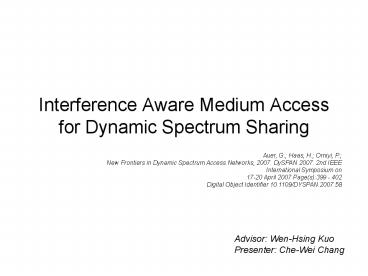Interference Aware Medium Access for Dynamic Spectrum Sharing - PowerPoint PPT Presentation
1 / 15
Title:
Interference Aware Medium Access for Dynamic Spectrum Sharing
Description:
One means to provide the transmitter with the relevant information has been ... data slot, nf, but spans typically only over one OFDM symbol in time. ... – PowerPoint PPT presentation
Number of Views:72
Avg rating:3.0/5.0
Title: Interference Aware Medium Access for Dynamic Spectrum Sharing
1
Interference Aware Medium Access for Dynamic
Spectrum Sharing
Auer, G. Haas, H. Omiyi, P.New Frontiers in
Dynamic Spectrum Access Networks, 2007. DySPAN
2007. 2nd IEEE International Symposium on17-20
April 2007 Page(s)399 - 402 Digital Object
Identifier 10.1109/DYSPAN.2007.58
Advisor Wen-Hsing Kuo Presenter Che-Wei Chang
2
Abstract
- We address dynamic spectrum sharing for future
mobile communication systems where multiple
operators share license exempt spectrum. - They propose dynamic spectrum assignment (DSA)
based on busy burst (BB) signaling. - Due to its decentralized nature, the considered
BB-DSA protocol appears to be ideally suited for
dynamic spectrum sharing in license exempt
spectrum.
3
Contents
- Introduction
- Dynamic Channel Assignment
- Dynamic Spectrum Assignment Using Busy Bursts
- Delay-Throughput Performance
- System Model
- Results
- Conclusions
4
Introduction(1/3)
Fig. 1. Network deployment scenario Base
stations are randomly placed, giving rise to
significant cell overlap.
In the traditional way, where base station (BS)
sites are carefully placed to minimize the
interference between cells may no longer be
feasible.
5
Introduction(2/3)
- In this paper, the ability of the MAC to solve
the interference scenarios which result in the
hidden and exposed node problems is emphasized,
as these problems pose fundamental challenges to
realize the vision of a cognitive radio. - One means to provide the transmitter with the
relevant information has been identified by the
busy-signal approach 13. - By letting receivers transmit either an out of
band busy-tone 1 or an in-band busy-burst in an
associated mini-slot 2, 3.
6
Introduction(3/3)
- Two important goals are accomplished
- First, with minimum signaling overhead the own
transmitter is informed about the level of
interference at the receiver. - Second, at the same time other nodes intending to
establish a transmission are notified about
ongoing transmissions, so that these nodes can
take appropriate steps to avoid interference. - The price to be paid for the busy-tone is an
additional overhead, typically about 10 of the
available bandwidth.
7
Dynamic Channel Assignment
Fig. 2. Example of inter-cellular interference
scenario.
8
Busy-tone concept
- The key principle of the busy-tone concept is
that the receiver sends out a busy-signal on a
time-multiplexed channel when it has successfully
received a data packet 2. - In case an outage occurred or the transmitter has
no more data to transmit, no busy burst is
broadcast by the target receiver and the slot
remains unreserved.
9
Dynamic Spectrum Assignment Using Busy
Bursts(1/2)
- Typically, groups of nf subcarriers and nt OFDM
symbols are grouped together to form a
frequencytime resource unit, termed slots.
Fig. 3. MAC frame structure including in-band
minislots for busy-signaling.
10
Dynamic Spectrum Assignment Using Busy
Bursts(2/2)
- A minislot occupies the same number of
subcarriers as the corresponding data slot, nf,
but spans typically only over one OFDM symbol in
time. - So, any frequency slot scheduled for a certain
user has a minislot reserved for the feedback
link from receiver to transmitter. - In case an outage occurred or the transmitter has
no more data to transmit, no busy burst is
broadcast and the slot remains unreserved.
11
Delay-Throughput Performance
- The throughput R and delay D are a function of
the inter-cell interference and the process of
packet burst arrivals.
The mean arrival rate into the slot is
packets per slot
is the expected uninterrupted transmission time.
12
System Model
- An OFDM system with 256 subcarriers and 10 OFDM
symbols per frame is used for a numerical
example. - With a slot size of nf nt 32 10 there are 8
parallel slots available. - With a minislot duration of one OFDM symbol the
BB-DSA minislot overhead is 10. - A pathloss exponent and the shadow fading
standard deviation of 3 and 8 dB was assumed. - an average number of interferers ?o 6, assumed
to be Poisson distributed. - The uninterrupted transmission time is EwTx
300 frames.
13
Results
Fig. 4. Delay-throughput results for cell size
Rcell 1km.
14
Conclusions
- Dynamic spectrum assignment using busy bursts
(BB-DSA) is a fully decentralized protocol with
interference avoidance and link adaptation
capabilities. - Effectively supports dynamic spectrum management
and dynamically changing network topologies. - This is demonstrated by the throughput-delay
performance which significantly outperforms
spectrum allocation without interference
avoidance.
15
Thanks for Your Attention!































